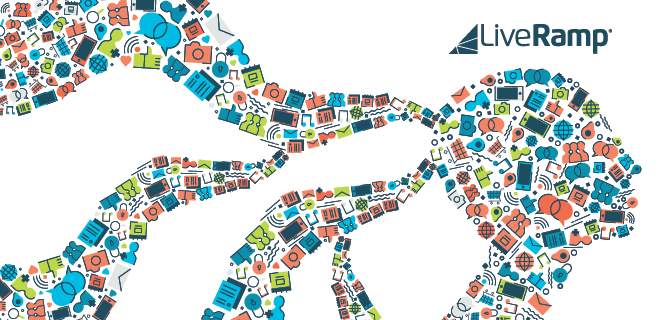
What’s next after cookies?
That’s what every buyer and seller wants to know.
And now that Google has called a major timeout, and FLoC is potentially being revised to focus on topic groups as opposed to interest groups, finding alternative solutions that can help solve for the loss of the cookie right now has become more important than ever.
It’s also the right time for publishers to start thinking about building stronger relationships with their audiences to think beyond first-party data towards getting started with zero-party data. The strategy: obtaining consumer’s consent to share their data to receive personalized experiences.
But once you have that data you need a means of making that data valuable. You need to be able to authenticate your data to power retargeting, audience building, insights, and attribution.
We spoke with Dev Pragad, CEO, Newsweek, about how the publisher is building better relationships with their audience toward the goal of zero-party data exchange, as well as how they’re using LiveRamp’s Authenticated Traffic Solution (ATS) to drive CPMs. We also spoke with Scott Howe, CEO, LiveRamp, to learn more about ATS, how Newsweek drove a total eCPM as high as 224%, with an average lift of 52% across all web browsers using it, as well as how publishers should evaluate partners to survive and thrive in the cookieless future.
Lynne d Johnson: Although consumers have found cookie-tracking mixed with programmatic advertising to be creepy, most consumers still want personalized experiences when they visit websites and also to have a seamless experience across devices and properties when dealing with one brand. Can you talk about why zero-party data is the future of digital media and advertising?
Dev Pragad: As a publisher, and as any business in general, it’s necessary to create an environment that is safe and transparent, fostering trust with your audience. When that’s achieved, readers feel comfortable sharing their opinions, intentions, and objectives. In turn, that creates the perfect scenario for zero-party data exchange. If users are inclined to share interests and preferences with a publisher, it gives them vital insights into what products to develop and where best to invest.
LdJ: What are some of the challenges publishers face with getting consumers to share their data and what are some of the strategies they can employ to achieve this goal? Can you provide some examples of the strategies and tactics that Newsweek is using to authenticate first-party data?
DP: With consumers’ growing concerns about privacy and misuse of information, readers are unsurprisingly being mindful about sharing their data. As a result, publishers need to find avenues for adding value to the relationship — through content or creative features, including polls and quizzes — where readers’ are prone to share data in exchange for access and participation. In addition to these sorts of solutions, we are investing in a wider mix of newsletter content to heighten our connection to our users. Keeping a clean database of engaged readers is key for this process.
LdJ: One thing we keep hearing publishers say is that they’re only going to invest resources in cookieless solutions where they can guarantee that advertisers will buy. The end of cookies seems like a perfect opportunity for publishers to have the upper hand. How is Newsweek thinking about this? Do you have plans to onboard advertiser data, or provide other services to advertisers where you’re helping them to understand their audiences better?
DP: We think of it positively. It is an opportunity to improve user experience and it gives us better control of the data — all being shared in a privacy-safe manner. Matching user-provided data and interests to advertiser needs first-hand would ultimately provide advertisers with better results for their marketing campaigns.
LdJ: Let’s talk about revenue. One of the major concerns that publishers have about life without cookies is an overwhelming reduction in revenues. Is this a concern for Newsweek? What are some of the results that you’re already seeing with your tests of alternative identifiers both in terms of revenue and also in terms of advertiser ROI?
DP: Newsweek has been concerned about the depreciation of the cookie and our team has been experimenting with potential ID solutions. In particular, we’ve already seen some success with LiveRamp’s Authenticated Solution (ATS). Leveraging ATS, we have seen a CPM lift of 55% on Google Chrome browsers, and a 93% and 60% CPM lift on Firefox and Safari, respectively. The lift in specific browsers demonstrates the significant impact ATS can drive as an alternative to third-party cookies.
LdJ: How does ATS work and how does it help publishers prepare to survive in a world without cookies?
Scott Howe: LiveRamp’s Authenticated Traffic Solution (ATS) allows publishers to connect authenticated inventory to marketer demand without third-party cookies or other device-based identifiers. ATS provides enhanced user privacy by offering users control over how their data is being used with a single opt-out that is effective for platforms and publishers who work with LiveRamp.
The industry is embracing ATS because it is a better solution than what it is replacing. Our authentication solution is the only truly neutral, omnichannel, and global technology available.
Benefits of using ATS include:
- Relevant, addressable, and measurable consumer interactions due to its omnichannel, people-based approach
- Placing consumer transparency and control above all else. It champions the importance of first-party, authenticated relationships, enabling a direct connection between a publisher’s authenticated first-party data and marketer demand.
- Support of innovative and privacy-centric reader engagement models, resulting in higher yields for publishers.
- Increased audience addressability in cookieless environments.
- Increased advertiser demand while maintaining a responsive user experience.
As a result, publishers make more money, marketers generate higher returns, and consumers gain greater control and transparency over their data.
ATS mimics the very approach Google has taken but enables these capabilities for non-walled garden publishers so that the open web can compete on a level playing field and publishers can continue to provide the free content we all enjoy. Through login events, publishers can connect data with their ad tech stack. And by leveraging ATS controls, publishers always remain in control of their data.
LdJ: A couple of things that many publishers worry about with authenticating traffic is disrupting the user experience, as well as sign-in fatigue across the open web. What are some of the ways the industry can solve for this?
SH: One of the main benefits to authenticating traffic is that it champions the importance of first-party, consented relationships, enabling a direct connection between a publisher’s authenticated first-party data and marketer demand. In speaking with publishers, there is nothing more valuable than providing the experiences consumers expect and welcome, so building first-party relationships is a critical foundation for success. When done right, a first-party data strategy will result in a deeper understanding of a reader/user.
When and where you ask consumers to authenticate (and provide some level of first-party data) requires continuous testing and iteration. Whether it’s your website or a mobile app, be sure to take every opportunity to offer compelling content before asking for an authentication or a device prompt like Apple’s ATT is displayed. What’s key here is understanding when to make “the ask” to convert. Too often, gates or permission dialogues are forced early in the process. With so much focus on collecting data, this is understandable, but can also cause a poor experience early in an engagement.
From there, you can nurture a relationship by providing content recommendations on the same topics or from similar authors the consumer may enjoy (e.g. “weekend edition”, newsletter, etc.) to encourage further engagement. If you’re subscription-based and provide content that resonates with consumers, they may become a paying customer. Regardless of whether they pay or authenticate, you will be able to strengthen first-party relationships and deliver more relevant experiences to consumers.
LdJ: How can publishers either maintain or achieve even higher yields with a solution like yours versus the third-party cookie?
Paving the way for a cookieless world starts where it always has: with the very companies who are producing the content we consume and love—publishers.
In order to maintain or achieve higher yields with an authenticated solution like ours, publishers need not authenticate a disproportionate amount of your audience to generate meaningful upside. While some publishers enjoy authentication rates in excess of 90% given their subscription content, others are worried about making the transition. Even at low levels of authentication – 10% – 15% — the impact can be disproportionately valuable.
Take an illustrative, but absolutely representative, example of a publisher authenticating only 10% of its visitors. We know that audiences who trust your site enough to provide an email, mobile number, or other lightweight authentication, tend to be heavier users. Assuming your authenticated users consume just 50% more content on average, 10% of users equals 15% of total page views. And across all publishers, we’re seeing authenticated traffic monetize at 125% better yields than cookies, which suggests that these same users contribute disproportionate revenue.
The results we’re seeing with partners like Newsweek are incredible. In a world of true user authentication, everyone wins.
The Newsweek team saw total lift in eCPM as high as 224%, with an average lift of 52% across all web browsers. The lift in specific browsers indicates the significant impact ATS can drive as an alternative to third-party cookies and in cookieless environments.
Because both Firefox and Safari no longer enable audience reach with third-party cookies, the lift on both browsers demonstrates how ATS enables a new, more premium channel based on authentications where marketers and advertisers can reach an audience they were not previously able to.
On mobile devices, publishers are also seeing a higher CPM than on cookieless mobile web inventory. Through ATS, Newsweek also achieved a CPM lift of 53% on iOS.
These CPM improvements illustrate the incremental revenue opportunities achieved by leveraging an authenticated solution. Data-driven publishers that have built first-party relationships over time are in a position to leverage their authenticated data to enable marketers to target audiences and measure campaign outcomes with people-based identity — something buying on third-party cookies was never able to achieve.
LdJ: As publishers start looking at alternatives to cookies, how should they be evaluating partners?
SH: The loss of cookies will have a major effect on the industry. When evaluating technology vendors, we recommend publishers (and brands) take the initiative to work with proven partners. While it’s an exciting time to reinvent, there is no perfect solution. Ultimately, publishers need to use a combination of tools to address the post-cookie ecosystem. The mix will vary based on need: authentications, browser cohorts, and unauthenticated publisher data.
Here are four criteria publishers should focus on as they are evaluating technology partners, regardless of the solution:
- Meet modern expectations for user privacy and security. Does the vendor you’re evaluating have a thoughtful approach and key workflows to support consumer privacy and security that is ready to adapt as privacy regulations evolve?
- Make the value exchange crystal clear. Does the business clearly explain the value exchange to consumers? Does it deploy robust disclosure, notice, and control mechanisms? We see authentications as a mechanism for transparency. Only when people have a transparent understanding of this value exchange will they feel more comfortable and able to make an informed choice about offering their personal information.
- Be effective, omnichannel, and competitive with what exists in other channels. Is the solution scaled, competitive and interoperable in order to be effective not only on the web, but in mobile, offline, CTV, and beyond? Identity solutions help ensure consumer dollars continue to be spent on the web, support free or low-cost content, and promote ongoing customer engagement across the tech ecosystem.
- Choose a partner with global scale. Content and commerce require reaching consumers and marketers around the world. Even predominantly U.S.-based companies serve customers across many markets. Naturally, this requires a solution that scales globally and can help publishers make the marketing connections they need to drive the business outcomes they desire.
As a publisher, if the solution you’re vetting meets these criteria, you’re on the right path to effectively maintain the addressability enterprises need with the privacy and security features consumers deserve.

